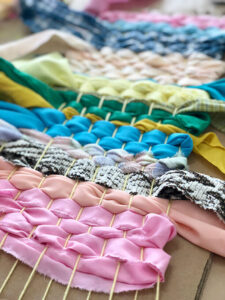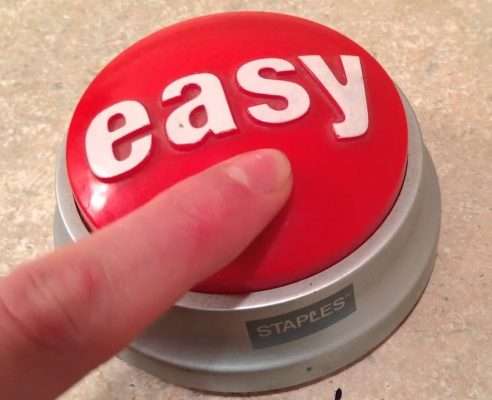Way back, at the beginning of my career, I was hired by a regional school system. I graduated with my art teaching certificate in May in addition to a raging case of mononucleosis. I desperately wished to be employed and out of my parent’s house by September. With a little luck, I both surprised my family (and maybe myself a little) in landing a teaching job. My next challenge was subsisting on a first-year teacher salary in a community that prided itself in being ranked the second-lowest salaries in the region.
I was the sixth art teacher at this high school and the principal had just eeked out funding for the position that school year. What they didn’t eke out was any more in the supply budget. Supply orders had been placed and filled well before I stepped foot in the school. I had a room but there wasn’t much by way of supplies. There was a common supply room for the art teachers with general materials they purchased in bulk- drawing papers, oak tag, and construction paper for example. Meanwhile, I was in debt to my parents as I borrowed money for things like first and last month’s deposit and car insurance. My student loans were starting up soon and I had to be really careful with my cash flow. In my first week of teaching, I literally went home and slept in a sleeping bag on a wood floor because who had the money for a bed or furniture?
Each one of us has stories to tell from our first year of teaching and I am no different. My stories include scrounging supplies for roughly one hundred and forty students for 185 school days because God didn’t even grant us any snow days resulting in five extra teaching days. Even beyond that year, I was always being thrifty as budgets in the public schools never allowed for many extras. Here is some wisdom I garnished over the years:
Necessity is the mother of invention
Did I mention that half my classes were Crafts classes? Of course, I had classes highly dependent on materials. And despite it all, I developed some keeper lessons. I was in a fancy gift store and spotted handmade marbled paper gift bags. I went home, ordered some marbling powder (seven dollars at the time), and deconstructed a gift bag to create a template. And this lesson was born and my students were thrilled with not only their gift bags but nested origami boxes as well done prior to the winter holidays. See the lesson, the downloadable box instructions, and the bag template. It was an excellent lesson to teach ruler skills and students went home for the holidays with something to show off.
Recycle Recycle Recycle!
It must have been an art teacher that coined the term “One man’s trash is another man’s treasure.” No shoebox is ever thrown away in my house! That’s a fine container I can store something in my classroom! Seriously, collagraph plates, collages, and Lois Nevelson-style sculptures are just a sampling of lessons that can be done with materials that might otherwise be thrown away.
Do you know how much cardboard enters a school over the summer and into the beginning of the school year? Make friends with your custodian because they can help you collect a stash. In my town, you can walk the streets on recycling day and have as much cardboard as you like. Check out the My Art Lesson Claes Oldenburg Cardboard Sculptures lesson. There are so many lessons, you can make it into a unit!
My first year I found myself with lots of random yarn and fabric and wound up creating wall-hanging weavings with these random collections and sticks I foraged in the woods. Collage was another way to use up odd material and encourage students to find materials for themselves.

Also, look for material exchange programs and Freecycle groups in your area. Yard sales, a favorite hobby of mine, is another great source of inexpensive finds for things like still life items.
Think Cheap!
I knew an art teacher who was a fine artist herself and really appreciated good supplies and ordered good supplies with her private school budget. I admired her willingness to splurge on good materials but my own spending habits were to scrimp and stretch each dollar. After years of inadequate budget, it was deep in my soul. My students learned perfectly well with student grade paint and never undervalue simple paper and pencil.
I looked for lessons and materials that challenged them but were budget-friendly. My three-dimensional classes were challenged to create sculptures from toothpicks. And another fabulous lesson, “Styrogomi,” was born of deconstructing styrofoam cups by artist J. Jules Vitali. You can find many styrogomi lessons based on his work.
Ask and you shall receive
In my first year of teaching, I put out an SOS to staff, family, and anyone who would listen. At school, I typed up a list of items people might have and be glad to donate like yarn, crayons, markers, etc. For paint mixing, a colleague brought in baby food jars I also forged relationships with the local frame business who provided an enormous amount of quality matboard after the Christmas season. I cultivated relationships with the librarian who would provide periodic newspapers and magazines she was discarding. I developed a student favorite self-portrait collage lesson with those magazines. Be sure to check with the school administration on policies related to asking and receiving school donations.
I survived my first year and many years after that, but always with a budget. Not always with a great budget! Over the years I worked out a system where I allowed myself to reach in my pocket for some conveniences, it helped me stay sane! I capped it though because it’s so easy for those expenses to really add up and it’s not like teachers are making the big money. It was only fair to myself, my family, and even my colleagues to do so. It is an unfortunate reality that teachers aren’t always properly supplied. It is true that my tight budgets have taught me to be creative within constraints and some wonderful lessons have resulted.
Check out low cost lessons:




